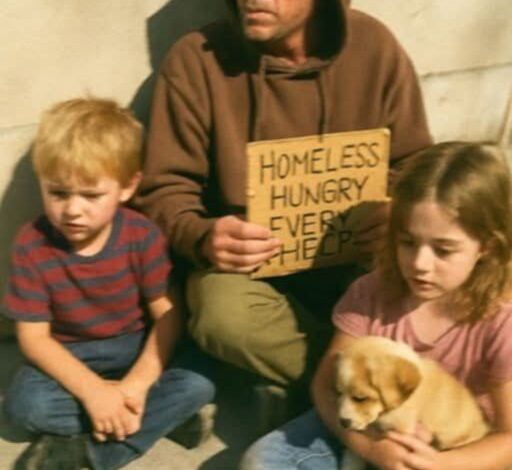HOMELESS BUT HOPEFUL: HOW MY DAUGHTER’S COMPASSION CHANGED OUR LIVES

The most challenging aspect of homelessness isn’t sleeping on cold concrete or enduring strangers’ avoidant glances. It’s explaining to your children why their friendships have faded, why their shoes don’t fit anymore, and why dinner sometimes consists of just half a granola bar.
Our family found ourselves without shelter for six difficult weeks. After losing my job during a factory closure, our lives unraveled with startling speed—eviction notice, temporary motel stays, then nothing but the streets.
Sometimes my hand-written cardboard sign generated compassion. My seven-year-old daughter insisted on decorating it with her crayons, believing that “more people might care” if it looked presentable.
My son stopped asking about returning “home” after the first week. He became quiet and withdrawn, sitting with knees pulled to his chest, silently watching passing vehicles. Yet he still found joy in our puppy’s occasional sneezes.
That stray puppy—a small, hungry bundle of fur without a collar—appeared behind a dumpster shortly after our last night in a proper shelter. My daughter named her Clover.
Despite her own hunger, my daughter always shared her meager food with Clover first. She wrapped the puppy in her own hoodie during cold nights, prioritizing the dog’s comfort even when shivering herself.
A Chance Encounter Changes Everything
One remarkable day, a woman stopped to speak with us.
She knelt down, gently petted Clover, and asked my daughter her name.
Then she asked for mine.
Before leaving, she handed me a business card identifying her as a “Family Transition Advocate.”
I wasn’t certain if this represented genuine assistance or another disappointment.
But I was determined to find out.
Following the address printed on the card led our family to a modest office situated between a laundromat and bakery. The aroma of freshly baked bread greeted us upon arrival, making our empty stomachs growl in response. Inside, colorful posters displaying community resources and inspirational messages covered the walls. We received a genuinely warm welcome from the receptionist—a kindness that caught me by surprise.
Ms. Delgado, the advocate who had given me her card, turned out to be a grandmotherly woman with compassionate eyes and practical solutions. She listened without judgment as I explained our circumstances, nodding thoughtfully while my daughter Savannah cradled Clover contentedly in her lap. When I mentioned the factory shutdown, her expression brightened with recognition.
“You should know,” she said while reaching for a folder, “the old textile mill on 5th Street is reopening next month. They’re prioritizing single parents for hiring, with benefits including childcare assistance.” She slid an application form across her desk. “And while we prepare for that opportunity, temporary family housing is available through our new shelter program.”
From Homeless to Hopeful
That evening, we slept in real beds for the first time in weeks. The shelter provided bunk beds that felt luxurious compared to park benches. Savannah immediately claimed the top bunk, carefully arranging her few possessions—including Clover’s makeshift bed—with meticulous care. My son Liam finally became talkative again, enthusiastically describing his dream of someday having his own room.
The following morning brought an unexpected development. While completing the mill’s application, I noticed a familiar face at the shelter’s breakfast area—Mr. Thompson, my former supervisor from the closed factory. He was volunteering his mornings serving coffee and pastries donated by local businesses. His eyes widened in surprise when he recognized me.
“Maria!” he exclaimed. “Ms. Delgado mentioned your situation. Listen, the new owners desperately need experienced workers. Your previous position is essentially waiting for you.” His expression turned serious. “And remember how I always encouraged you to apply for management training? Well, this time I’m making it happen.”
Continue reading on next page…